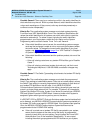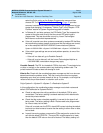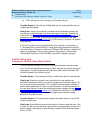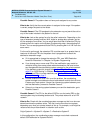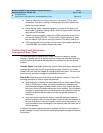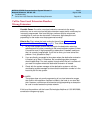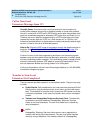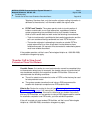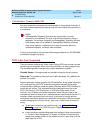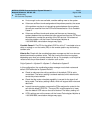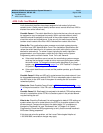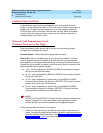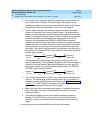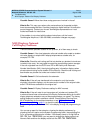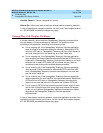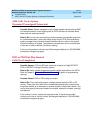
MERLIN LEGEND Communications System Release 6.1
Network Reference
555-661-150
Issue 1
August 1998
Troubleshooting
Page 6-17Conference: Cannot Add Call
6
Conference: Cannot Add Call 6
Non-local extensions are treated as outside parties for the purpose of transfer. A
non-local conference participant takes up one of the two outside calls permitted in
a conference.
NOTE:
A PassageWay Telephony Services client cannot add a non-local
extension to a conference. The user must add the conferee by using a
telephone. If a conferee is dropped, the PassageWay Telephony Services
client display does not so indicate. A PassageWay Telephony Services
client, when added to a conference, only sees information about the
conference originator, not about other conferees.
If this is not the problem, call the Lucent Technologies Helpline at 1 800 628-2888;
consultation charges may apply.
DID Calls Not Completed 6
There are several reasons why Direct Inward Dialing (DID) calls across a private
network may not complete, either due to busy facilities or to faulty programming.
The coordinating system manager may need to address the problem.
Possible Cause 1:
All programmed and available routes for the call are busy.
What to do: This problem solves itself when traffic decreases. Only address the
problem if it persists.
Note the extension number range for the DID destination. At the system where the
call is received from the PSTN, check that the pattern assigned to the range
includes sufficient different routes with pools (of tandem and/or PSTN facilities) to
handle the call volume. This is accomplished by checking the error for errors
4C01 (Pool Empty), 4C02 (Pool Busy), or 4C03 (Pool Busy and/or Out-of-
Service). If any of these error codes are present, check the pool index on the
maintenance screen to determine if it matches the pool used to deliver the call. If it
matches, check occurrence times and count. If the count is too high and the
occurrences indicate the problem occurred within the duration of the occurrences,
consider changing the routing of the call, pool sizes, or add trunks to the pool if
empty.
■ To add more routes that can handle the call, see “Uniform Dial Plan
Routing” on page 25 or “UDP Routing” in Chapter 4 of
System
Programming.
■ If more trunks are available and need to be assigned, follow the procedure
in “Trunks to Pools Assignment” in Chapter 4 of
System Programming
to
assign more tandem trunks. All the tandem trunks in a pool must be of the
same type (tie or PRI).



